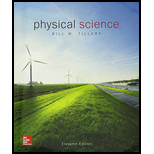
Physical Science + Connect Access Card
11th Edition
ISBN: 9781259731006
Author: Bill W. Tillery
Publisher: McGraw-Hill College
expand_more
expand_more
format_list_bulleted
Concept explainers
Question
Chapter 8, Problem 3AC
To determine
From the following options, in accordance to Rutherford’s calculations, the volume of an atom is mostly:
occupied by protons and neutrons.
filled with electrons.
occupied by tightly bound protons, electrons, and neutrons.
empty space.
Expert Solution & Answer
Want to see the full answer?
Check out a sample textbook solution
Students have asked these similar questions
Concept Simulation 26.4 provides the option of exploring the ray diagram that applies to this
problem. The distance between an object and its image formed by a diverging lens is 5.90 cm.
The focal length of the lens is -2.60 cm. Find (a) the image distance and (b) the object distance.
Pls help ASAP
Pls help ASAP
Chapter 8 Solutions
Physical Science + Connect Access Card
Ch. 8 - Prob. 1ACCh. 8 - Prob. 2ACCh. 8 - Prob. 3ACCh. 8 - 4. Millikan measured the charge on oil droplets...Ch. 8 - Prob. 5ACCh. 8 - Prob. 6ACCh. 8 - Prob. 7ACCh. 8 - Prob. 8ACCh. 8 - Prob. 9ACCh. 8 - Prob. 10AC
Ch. 8 - Prob. 11ACCh. 8 - Prob. 12ACCh. 8 - Prob. 13ACCh. 8 - Prob. 14ACCh. 8 - Prob. 15ACCh. 8 - Prob. 16ACCh. 8 - Prob. 17ACCh. 8 - Prob. 18ACCh. 8 - Prob. 19ACCh. 8 - Prob. 20ACCh. 8 - Prob. 21ACCh. 8 - Prob. 22ACCh. 8 - Prob. 23ACCh. 8 - Prob. 24ACCh. 8 - Prob. 25ACCh. 8 - Prob. 26ACCh. 8 - 27. Elements that have properties of both the...Ch. 8 - Prob. 28ACCh. 8 - Prob. 29ACCh. 8 - Prob. 30ACCh. 8 - Prob. 31ACCh. 8 - Prob. 32ACCh. 8 - Prob. 33ACCh. 8 - Prob. 34ACCh. 8 - Prob. 35ACCh. 8 - Prob. 36ACCh. 8 - Prob. 37ACCh. 8 - Prob. 38ACCh. 8 - Prob. 39ACCh. 8 - Prob. 40ACCh. 8 - Prob. 41ACCh. 8 - Prob. 42ACCh. 8 - Prob. 43ACCh. 8 - Prob. 44ACCh. 8 - Prob. 45ACCh. 8 - Prob. 46ACCh. 8 - Prob. 47ACCh. 8 - Prob. 48ACCh. 8 - Prob. 49ACCh. 8 - Prob. 1QFTCh. 8 - Prob. 2QFTCh. 8 - Prob. 3QFTCh. 8 - Prob. 4QFTCh. 8 - Prob. 5QFTCh. 8 - Prob. 6QFTCh. 8 - Prob. 7QFTCh. 8 - Prob. 8QFTCh. 8 - Prob. 9QFTCh. 8 - Prob. 10QFTCh. 8 - Prob. 11QFTCh. 8 - Prob. 12QFTCh. 8 - Prob. 1FFACh. 8 - Prob. 2FFACh. 8 - Prob. 3FFACh. 8 - Prob. 4FFACh. 8 - Prob. 5FFACh. 8 - Prob. 6FFACh. 8 - Prob. 1PEBCh. 8 - Prob. 2PEBCh. 8 - Prob. 3PEBCh. 8 - Prob. 4PEBCh. 8 - Prob. 5PEBCh. 8 - 6. If the charge-to-mass ratio of a proton is 9.58...Ch. 8 - Prob. 7PEBCh. 8 - 8. Using any reference you wish, write the...Ch. 8 - Prob. 9PEBCh. 8 - 10. Referring to Figure 8.16 only, write the...Ch. 8 - 11. An electric motor draws a current of 11.5 A in...Ch. 8 - Prob. 12PEBCh. 8 - Prob. 13PEBCh. 8 - Prob. 14PEBCh. 8 - Prob. 15PEBCh. 8 - Prob. 16PEBCh. 8 - Prob. 17PEBCh. 8 - Prob. 18PEBCh. 8 - Prob. 19PEB
Knowledge Booster
Learn more about
Need a deep-dive on the concept behind this application? Look no further. Learn more about this topic, physics and related others by exploring similar questions and additional content below.Similar questions
arrow_back_ios
SEE MORE QUESTIONS
arrow_forward_ios
Recommended textbooks for you
 Physics for Scientists and Engineers with Modern ...PhysicsISBN:9781337553292Author:Raymond A. Serway, John W. JewettPublisher:Cengage Learning
Physics for Scientists and Engineers with Modern ...PhysicsISBN:9781337553292Author:Raymond A. Serway, John W. JewettPublisher:Cengage Learning College PhysicsPhysicsISBN:9781305952300Author:Raymond A. Serway, Chris VuillePublisher:Cengage Learning
College PhysicsPhysicsISBN:9781305952300Author:Raymond A. Serway, Chris VuillePublisher:Cengage Learning College PhysicsPhysicsISBN:9781285737027Author:Raymond A. Serway, Chris VuillePublisher:Cengage Learning
College PhysicsPhysicsISBN:9781285737027Author:Raymond A. Serway, Chris VuillePublisher:Cengage Learning College PhysicsPhysicsISBN:9781938168000Author:Paul Peter Urone, Roger HinrichsPublisher:OpenStax College
College PhysicsPhysicsISBN:9781938168000Author:Paul Peter Urone, Roger HinrichsPublisher:OpenStax College Principles of Physics: A Calculus-Based TextPhysicsISBN:9781133104261Author:Raymond A. Serway, John W. JewettPublisher:Cengage Learning
Principles of Physics: A Calculus-Based TextPhysicsISBN:9781133104261Author:Raymond A. Serway, John W. JewettPublisher:Cengage Learning University Physics Volume 3PhysicsISBN:9781938168185Author:William Moebs, Jeff SannyPublisher:OpenStax
University Physics Volume 3PhysicsISBN:9781938168185Author:William Moebs, Jeff SannyPublisher:OpenStax

Physics for Scientists and Engineers with Modern ...
Physics
ISBN:9781337553292
Author:Raymond A. Serway, John W. Jewett
Publisher:Cengage Learning

College Physics
Physics
ISBN:9781305952300
Author:Raymond A. Serway, Chris Vuille
Publisher:Cengage Learning

College Physics
Physics
ISBN:9781285737027
Author:Raymond A. Serway, Chris Vuille
Publisher:Cengage Learning

College Physics
Physics
ISBN:9781938168000
Author:Paul Peter Urone, Roger Hinrichs
Publisher:OpenStax College

Principles of Physics: A Calculus-Based Text
Physics
ISBN:9781133104261
Author:Raymond A. Serway, John W. Jewett
Publisher:Cengage Learning

University Physics Volume 3
Physics
ISBN:9781938168185
Author:William Moebs, Jeff Sanny
Publisher:OpenStax